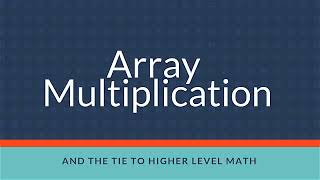Area multiplication models or array models that are taught in early grade levels are crazy valuable when you start working with polynomials and factoring. See how Adrianne builds the bridge from lower levels of math to polynomial factoring.
We offer all online math services featuring the multisensory math method which you can learn about here: madeformath.com/services
TRANSCRIPT
If we’re trying to teach our students how to do multiplication, we always use this model as well, arrays and with good reason. They’re really, really helpful for students in higher levels of math. If we’re looking at four times 13 or the reverse 13 times four, we always start with well, what’s 13 made of. So, let’s talk about that. We’ve talked about this in other videos before. Well, another way I can think of 13 is to say 10 plus three. That really helps me quickly multiply out these quantities. You can see here we’ve got our 10. 10 here and we’re multiplying that down four times. We’ve got four groups of 10 in here. Let me go ahead and make that group.
Okay, so we’ve got our 10 times four, well that’s 40. We’ve got a group of 40. Then we have this area that’s left over here on the side, the three. So, if I put those all in there that we’ve got 12 in here. Four times three. This makes for a really quick visual multiplication here we had. We have 40 here, and 12 over here. Then all we need to do is add those together. We can see here that we get 52. That was four times 13.
I really like teaching my students this and we rely on this scale a lot. It’s important as we’re moving forward in math to be able to do area multiplication like this or arrays would be another term for it. Let’s look at another example in higher levels of math here.
I’m going to go to my algebra tiles. Again, we have this area model. It’s really helpful when we’re trying to factor in the future to be able to see what it’s made of and determine the size. In the previous slide, we could see that one side was 13, or 10 plus three. The other side was four. Her the question is kind of similar. I can see that this is the area that I have. What are the sides made of? That’s what factorings about. Here I like these visuals because I can quickly look and determine what this first side here. This side here, what’s it made of. I can pull this out and look at this and I can see, okay, well, it’s got one side of it is the length of x. What’s the other side by the way, I can see that the other side is the same size as x.
I’m going to mark that down. One side of it is x. That’s really helpful as I can see what that’s made of. I’m going to delete these real quick. Then I need to figure out what’s this measurement over here. Now, it’s not x. I have four x’s here but we’re doing like the shared greatest common factor kind of thing so this length here from this green side to the edge of this green side, I can call that four. That’s like saying I have four. Over here we have x and down here I see that I’ve got two and they’re red and they’re negative. That’s minus two. It’s very easy for us to visually see how this works.
That’s one reason I really love it when teachers spend a lot of time teaching that array, the area multiplication model so that students can use it as they get older. When I’ve got students that are struggling with factoring, we go back to the basics. We go back to that example I showed you earlier. We talk about this is what it’s made of. Well, what’s it made of? We use a simplified example. What’s 13 times four, let’s draw an area model of that. I may not spend a ton of time drawing all of this. We can also talk about how important it is just to be efficient with our drawings there and I can draw a rectangle. I can say we’ve got this, this is 10, obviously it’s not to scale and I’m not going to worry about it. Then I can multiply and add those values inside. Got 40 and 12 over here. This is helpful for us to go back to a more simplified example with just regular multiplication without the variable piece.
Then we make that jump back to the algebra side and we talk about that. It builds a really nice bridge for our students so that they can understand what’s going on here. Then that variable multiplication, you can see it visually here and you can grasp and understand. What are the sides made of if I was making an area model? That’s really helpful for our students to have a bridge between topics they were taught when they were younger to the things that they’re working on right now. We use this in all areas. That’s one of the ways that we do multi-sensory math with our students.
If you’ve got questions about multi-sensory math, we would love to help you. Reach out to us over at Math for Middles. We have spots open for individual tutoring and we do small group tutoring in the summers. Thanks so much for joining me. We’ll talk to you again soon?
Did you like our multi-sensory math videos? Make sure you subscribe, like and share it with your friends. We’re planning on answering questions that you submit every single week. Make sure to join us here on YouTube or on Facebook. Send your questions in to hello@madeformath.com.

